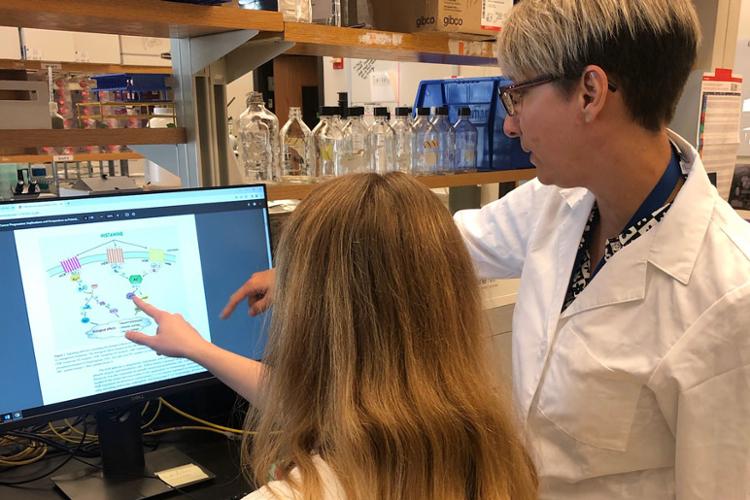Research
Cutting-edge Drug Discovery

The Gavegnano Group, led by Dr. Christina Gavegnano, studies inflammation as it relates to viral pathogenesis, with a specific focus on drug discovery and immunomodulation with small molecule inhibitors. Our team continues to pursue mechanistic studies to bolster additional understanding of the modulation of inflammation and its potential antiviral effects.
The Gavegnano Drug Discovery Program was established in 2022 and offers students a front row seat in the process of drug discovery, from idea to FDA-approved agent. To learn more, click here.
Recent News
- Mullin, Emily. "A Patient May Be Free of HIV, Thanks to This Drug." Wired, 27 Jul. 2023
- Hunt, April. "‘Drug discovery’ courses showcase the bench-to-bedside process." Emory News, 21 Apr. 2022
Co-Design Lab for Health Equity
 The Emory Co-Design Lab for Health Equity serves as a hub for thought-leadership and implementation science in the co-design of affordable health care and social innovation programs at Emory. The Co-Design Lab was co-founded by Human Health faculty Dr. Rachel Hall-Clifford and Dr. Gari Clifford, Chair of Emory’s Department of Biomedical Informatics. The Lab’s mission is to promote health equity through the co-design of health and social innovation programs with marginalized populations by harnessing low-cost, cutting-edge technologies. We work with partner organizations and community stakeholders to create solutions for community-identified health concerns. We believe that to achieve health equity, we must stop delivering health programs and start co-designing them.
The Emory Co-Design Lab for Health Equity serves as a hub for thought-leadership and implementation science in the co-design of affordable health care and social innovation programs at Emory. The Co-Design Lab was co-founded by Human Health faculty Dr. Rachel Hall-Clifford and Dr. Gari Clifford, Chair of Emory’s Department of Biomedical Informatics. The Lab’s mission is to promote health equity through the co-design of health and social innovation programs with marginalized populations by harnessing low-cost, cutting-edge technologies. We work with partner organizations and community stakeholders to create solutions for community-identified health concerns. We believe that to achieve health equity, we must stop delivering health programs and start co-designing them.
To learn more about the Emory Co-Design Lab, visit their website here.
Selected Publications
- 2021 NIH Fogarty International Center. mHealth app reduces LMIC pregnancy, delivery risks. Global Health Matters 20(4).
https://www.fic.nih.gov/News/GlobalHealthMatters/july-august-2021/Pages/mHealth-app-reduces-LMIC-pregnancy-delivery-risks.aspx - 2020 M Juarez, Y Juarez, E Coyote, T Nguyen, C Shaw, R Hall-Clifford, G Clifford, and P Rohloff. Working with lay midwives to improve the detection of neonatal complications in rural Guatemala. BMJ Open Quality, 9(1). http://dx.doi.org/10.1136/bmjoq-2019-000775
- 2018 B Martinez, E Coyote, R Hall-Clifford, M Juarez, AC Miller, A Francis CE Valderrama, L Stroux, GD, Clifford, P Rohloff. mHealth intervention to improve the continuum of maternal and perinatal care in rural Guatemala: a pragmatic, randomized controlled feasibility trial. Reproductive Health, 15(1): 120, 12 pages. https://doi.org/10.1186/s12978-018-0554-z.
- 2017 R Hall-Clifford, R Amerson. From Guidelines to Local Realities: Evaluation of oral rehydration therapy and zinc supplementation in Guatemala. Revista Panamericana de Salud Pública/Pan American Journal of Public Health 41:e8, 6 pages. https://www.scielosp.org/article/rpsp/2017.v41/e8/en/#.
- 2017 R Hall-Clifford, S Roche, S Fathima, N Palmius, K Hollingworth, J Kennedy, J Merida, M Stephens, R Lavalley, P Rohloff, P Garcia, G Clifford. Sustainable Technology for Surgical Referrals: Pilot Implementation of an Electronic Referral System for Short-Term Surgical Missions. Journal of Health Informatics in Developing Countries, 11(2), 26 pages. http://www.jhidc.org/index.php/jhidc/article/view/166/219.
Origins of Health
 The Origins of Health focuses on the theory, research and policy implications of the new science known as the Developmental Origins of Health and Disease. Our work in this area combines cutting edge discoveries in Predictive Health with the growing evidence for intergenerational contributions and environmental influences that have lifelong effects on health from the earliest days of development.
The Origins of Health focuses on the theory, research and policy implications of the new science known as the Developmental Origins of Health and Disease. Our work in this area combines cutting edge discoveries in Predictive Health with the growing evidence for intergenerational contributions and environmental influences that have lifelong effects on health from the earliest days of development.